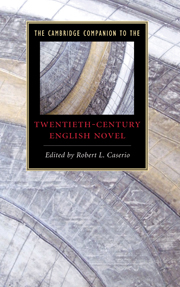Book contents
- Frontmatter
- Introduction
- 1 The art of English fiction in the twentieth century
- 2 The British Empire and the English modernist novel
- 3 Realism and rebellion in Edwardian and Georgian fiction
- 4 The Great War in English fiction
- 5 Postwar modernism in the 1920s and 1930s: The mammoth in the basement
- 6 Regionalism in English fiction between the wars
- 7 Ireland and English fiction
- 8 Feminist fiction
- 9 Working-class fiction across the century
- 10 World War II, the welfare state, and postwar “humanism”
- 11 The Windrush generation
- 12 History in fiction
- 13 Postmodernisms of English fiction
- 14 Detectives and spies
- 15 The post-consensus novel: Minority culture, multiculturalism, and transnational comparison
- 16 An absurd century: Varieties of satire
- 17 The other side of history: Fantasy, romance, horror, and science fiction
- Further reading
- Index
6 - Regionalism in English fiction between the wars
Published online by Cambridge University Press: 28 July 2009
- Frontmatter
- Introduction
- 1 The art of English fiction in the twentieth century
- 2 The British Empire and the English modernist novel
- 3 Realism and rebellion in Edwardian and Georgian fiction
- 4 The Great War in English fiction
- 5 Postwar modernism in the 1920s and 1930s: The mammoth in the basement
- 6 Regionalism in English fiction between the wars
- 7 Ireland and English fiction
- 8 Feminist fiction
- 9 Working-class fiction across the century
- 10 World War II, the welfare state, and postwar “humanism”
- 11 The Windrush generation
- 12 History in fiction
- 13 Postmodernisms of English fiction
- 14 Detectives and spies
- 15 The post-consensus novel: Minority culture, multiculturalism, and transnational comparison
- 16 An absurd century: Varieties of satire
- 17 The other side of history: Fantasy, romance, horror, and science fiction
- Further reading
- Index
Summary
Writing about romanticism in 1924, A. O. Lovejoy lamented that the word “romantic” had “come to mean so many things that, by itself, it means nothing. It has ceased to perform the function of a verbal sign.” While I will not suggest that a similar lament applies to terms like regionalism, an essay on the interwar English regional novel cannot afford to bracket similar worries. In a 1941 PEN pamphlet, The English Regional Novel, Phyllis Bentley identifies the 1920s and 1930s as a period of resurgence in regional fiction, a time during which novelists like Winifred Holtby added “the last touch of consciousness to the regional genre.” But what, after all, is “the regional”? A region can be as large as the European peninsula. Within the political enterprise that is the European Union, however, regions subdivide a continent already sliced up into nation-states - and even then what counts as a region is far from certain. According to the latest Map of European Regions, a region might be an abstract geographical area like “Mid East Ireland”; a subnational cultural and political unit like Bavaria; or a national but substate territory like Scotland or Wales. England appears to present a different problem altogether: the Assembly of European Regions divides it into some eighty-seven portions, including counties, parts of counties, and metropolitan authorities. Things are hardly more clear at the level of literary history, where “region” is used to describe something as diverse as multilingual and multi-national literatures of the Caribbean archipelago and as specific as 1960s “Liverpool Scene” poetry. If we are fully to grasp the implications of regionalism as a thematic and generic trend in English fiction of the interwar years, then we must first be clear about the protean nature of this thing called a region.
- Type
- Chapter
- Information
- Publisher: Cambridge University PressPrint publication year: 2009
- 2
- Cited by

